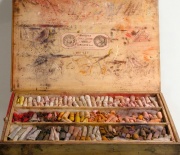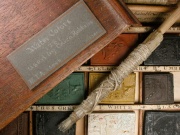Difference between revisions of "Pigment"
Jump to navigation
Jump to search
(username removed) |
JLBoutaine (talk | contribs) |
||
| Line 27: | Line 27: | ||
Claira Robbins]] | Claira Robbins]] | ||
| + | |||
| + | == Additional information == | ||
| + | |||
| + | * R.L. Feller, A. Roy, E. West Fizthugh, B. Berrie, Artists' pigments: A handbook of their history and characteristics (4 vol.), NGA (Washington DC) & Archetype Publications (London) | ||
| + | |||
== Synonyms and Related Terms == | == Synonyms and Related Terms == | ||
Revision as of 02:41, 25 February 2014
Description
An insoluble, dry solid that is pulverized to a fine powder then mixed with a binder to form a paint, ink or crayon.
Examples of inorganic pigments:
- earth colors (ocher, sienna, umber, green earth);
- metallic oxide (ferric oxide, titanium dioxide, zinc white; viridian);
- metallic carbonates (lead white, calcite, malachite);
- metallic chromates (lead chromate; barium chromate;
- carbon black (bone black, lampblack, graphite)
Examples of some organic pigments are:
- animal (melanin, cochineal, Indian yellow)
- vegetable (madder, indigo, gamboge)
- synthetic (verdigris, phthalocyanine, lakes, para red)
Additional information
- R.L. Feller, A. Roy, E. West Fizthugh, B. Berrie, Artists' pigments: A handbook of their history and characteristics (4 vol.), NGA (Washington DC) & Archetype Publications (London)
Synonyms and Related Terms
pigments (pl., Fr.); pigmento (Esp., Port.);
Comparisons
Websites of pigment manufacturers



